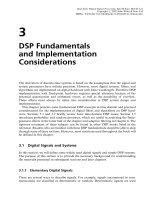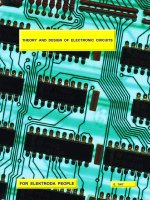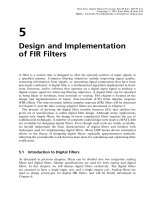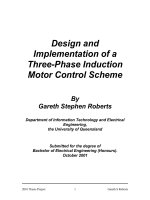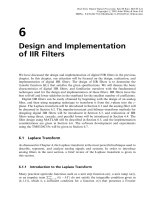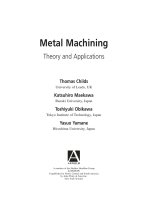PLC theory and implementation
Bạn đang xem bản rút gọn của tài liệu. Xem và tải ngay bản đầy đủ của tài liệu tại đây (5.3 MB, 1,047 trang )
Programmable Controllers
Theory and Implementation
Second Edition
L.A. Bryan
E.A. Bryan
T
HEORY
AND
I
MPLEMENTATION
PROGRAMMABLE
CONTROLLERS
An Industrial Text Company Publication
Atlanta • Georgia • USA
Second Edition
L. A. Bryan
E. A. Bryan
© 1988, 1997 by Industrial Text Company
Published by Industrial Text Company
All rights reserved
First edition 1988. Second edition 1997
Printed and bound in the United States of America
03 02 01 00 99 98 97 10 9 8 7 6 5 4 3 2
| | | | | | | | | | | |
| | | | | | | | | | | | | | |
| | | | | | | | | | | | | | |
| | | | | | | | | | | | | | |
Reproduction or translation of any part of this work beyond
that permitted by Sections 107 and 108 of the 1976 United
States Copyright act are unlawful.
Requests for permission, accompanying workbooks, or
further information should be addressed to:
Industrial Text and Video Company
1950 Spectrum Circle
Tower A-First Floor
Marietta, Georgia 30067
(770) 240-2200
(800) PLC-TEXT
Library of Congress Cataloging-in-Publication Data
Bryan, L.A.
Programmable controllers: theory and implementation/L.A. Bryan,
E.A. Bryan.—2nd ed.
p. cm.
Includes index.
ISBN 0-944107-32-X
1. Programmable controllers. I. Bryan, E.A. II. Title.
TJ223.P76B795 1997
629.8'9—dc21 96-49350
CIP
Due to the nature of this publication and because of the different applications of
programmable controllers, the readers or users and those responsible for applying the
information herein contained must satisfy themselves to the acceptability of each
application and the use of equipment therein mentioned. In no event shall the publisher
and others involved in this publication be liable for direct, indirect, or consequential
damages resulting from the use of any technique or equipment herein mentioned.
The illustrations, charts, and examples in this book are intended solely to illustrate the
methods used in each application example. The publisher and others involved in this
publication cannot assume responsibility or liability for actual use based on the
illustrative uses and applications.
No patent liability is assumed with respect to use of information, circuits, illustrations,
equipment, or software described in this text.
Industrial Text & Video Company 1-800-752-8398
www.industrialtext.com
iii
Contents
Industrial Text & Video Company 1-800-752-8398
www.industrialtext.com
C
ONTENTS
Preface ix
About the Authors x
How to Use this Book xi
S
ECTION
1I
NTRODUCTORY
C
ONCEPTS
Chapter 1 Introduction to Programmable Controllers
1-1 Definition 4
1-2 A Historical Background 5
1-3 Principles of Operation 10
1-4 PLCs Versus Other Types of Controls 13
1-5 PLC Product Application Ranges 22
1-6 Ladder Diagrams and the PLC 24
1-7 Advantages of PLCs 26
Chapter 2 Number Systems and Codes
2-1 Number Systems 34
2-2 Number Conversions 41
2-3 One’s and Two’s Complement 43
2-4 Binary Codes 46
2-5 Register Word Formats 50
Chapter 3 Logic Concepts
3-1 The Binary Concept 56
3-2 Logic Functions 57
3-3 Principles of Boolean Algebra and Logic 64
3-4 PLC Circuits and Logic Contact Symbology 68
S
ECTION
2C
OMPONENTS
AND
S
YSTEMS
Chapter 4 Processors, the Power Supply, and Programming Devices
4-1 Introduction 82
4-2 Processors 84
4-3 Processor Scan 86
4-4 Error Checking and Diagnostics 92
4-5 The System Power Supply 98
4-6 Programming Devices 104
Chapter 5 The Memory System and I/O Interaction
5-1 Memory Overview 110
5-2 Memory Types 111
5-3 Memory Structure and Capacity 115
5-4 Memory Organization and I/O Interaction 119
iv
Contents
Industrial Text & Video Company 1-800-752-8398
www.industrialtext.com
5-5 Configuring the PLC Memory—I/O Addressing 127
5-6 Summary of Memory, Scanning, and I/O Interaction 132
5-7 Memory Considerations 133
Chapter 6 The Discrete Input/Output System
6-1 Introduction to Discrete I/O Systems 138
6-2 I/O Rack Enclosures and Table Mapping 139
6-3 Remote I/O Systems 146
6-4 PLC Instructions for Discrete Inputs 147
6-5 Types of Discrete Inputs 150
6-6 PLC Instructions for Discrete Outputs 162
6-7 Discrete Outputs 165
6-8 Discrete Bypass/Control Stations 177
6-9 Interpreting I/O Specifications 178
6-10 Summary of Discrete I/O 182
Chapter 7 The Analog Input/Output System
7-1 Overview of Analog Input Signals 186
7-2 Instructions for Analog Input Modules 187
7-3 Analog Input Data Representation 189
7-4 Analog Input Data Handling 196
7-5 Analog Input Connections 199
7-6 Overview of Analog Output Signals 201
7-7 Instructions for Analog Output Modules 201
7-8 Analog Output Data Representation 203
7-9 Analog Output Data Handling 207
7-10 Analog Output Connections 213
7-11 Analog Output Bypass/Control Stations 214
Chapter 8 Special Function I/O and Serial Communication Interfacing
8-1 Introduction to Special I/O Modules 218
8-2 Special Discrete Interfaces 220
8-3 Special Analog, Temperature, and PID Interfaces 224
8-4 Positioning Interfaces 233
8-5 ASCII, Computer, and Network Interfaces 248
8-6 Fuzzy Logic Interfaces 255
8-7 Peripheral Interfacing 260
S
ECTION
3 PLC P
ROGRAMMING
Chapter 9 Programming Languages
9-1 Introduction to Programming Languages 276
9-2 Types of PLC Languages 276
9-3 Ladder Diagram Format 282
9-4 Ladder Relay Instructions 289
9-5 Ladder Relay Programming 298
9-6 Timers and Counters 306
9-7 Timer Instructions 308
v
Contents
Industrial Text & Video Company 1-800-752-8398
www.industrialtext.com
9-8 Counter Instructions 312
9-9 Program/Flow Control Instructions 317
9-10 Arithmetic Instructions 322
9-11 Data Manipulation Instructions 334
9-12 Data Transfer Instructions 348
9-13 Special Function Instructions 358
9-14 Network Communication Instructions 363
9-15 Boolean Mnemonics 369
Chapter 10 The IEC 1131 Standard and Programming Language
10-1 Introduction to the IEC 1131 374
10-2 IEC 1131-3 Programming Languages 380
10-3 Sequential Function Chart Programming 403
10-4 Types of Step Actions 419
10-5 IEC 1131-3 Software Systems 429
10-6 Summary 439
Chapter 11 System Programming and Implementation
11-1 Control Task Definition 444
11-2 Control Strategy 444
11-3 Implementation Guidelines 445
11-4 Programming Organization and Implementation 446
11-5 Discrete I/O Control Programming 465
11-6 Analog I/O Control Programming 492
11-7 Short Programming Examples 521
Chapter 12 PLC System Documentation
12-1 Introduction to Documentation 536
12-2 Steps for Documentation 537
12-3 PLC Documentation Systems 547
12-4 Conclusion 549
S
ECTION
4 PLC P
ROCESS
A
PPLICATIONS
Chapter 13 Data Measurements and Transducers
13-1 Basic Measurement Concepts 554
13-2 Interpreting Errors in Measurements 560
13-3 Transducer Measurements 565
13-4 Thermal Transducers 572
13-5 Displacement Transducers 586
13-6 Pressure Transducers 588
13-7 Flow Transducers 591
13-8 Vibration Transducers 599
13-9 Summary 608
Chapter 14 Process Responses and Transfer Functions
14-1 Process Control Basics 610
14-2 Control System Parameters 614
vi
Contents
Industrial Text & Video Company 1-800-752-8398
www.industrialtext.com
14-3 Process Dynamics 623
14-4 Laplace Transform Basics 632
14-5 Dead Time Responses in Laplace Form 644
14-6 Lag Responses in Laplace Form 645
14-7 Types of Second-Order Responses 653
14-8 Summary 665
Chapter 15 Process Controllers and Loop Tuning
15-1 Introduction 670
15-2 Controller Actions 671
15-3 Discrete-Mode Controllers 676
15-4 Continuous-Mode Controllers 690
15-5 Proportional Controllers (P Mode) 692
15-6 Integral Controllers (I Mode) 706
15-7 Proportional-Integral Controllers (PI Mode) 715
15-8 Derivative Controllers (D Mode) 725
15-9 Proportional-Derivative Controllers (PD Mode) 729
15-10 Proportional-Integral-Derivative Controllers (PID Mode) 736
15-11 Advanced Control Systems 744
15-12 Controller Loop Tuning 747
15-13 Summary 766
S
ECTION
5A
DVANCED
PLC T
OPICS
AND
N
ETWORKS
Chapter 16 Artificial Intelligence and PLC Systems
16-1 Introduction to AI Systems 774
16-2 Types of AI Systems 774
16-3 Organizational Structure of an AI System 776
16-4 Knowledge Representation 778
16-5 Knowledge Inference 781
16-6 AI Fault Diagnostics Application 788
Chapter 17 Fuzzy Logic
17-1 Introduction to Fuzzy Logic 798
17-2 History of Fuzzy Logic 801
17-3 Fuzzy Logic Operation 802
17-4 Fuzzy Logic Control Components 805
17-5 Fuzzy Logic Control Example 828
17-6 Fuzzy Logic Design Guidelines 835
Chapter 18 Local Area Networks
18-1 History of Local Area Networks 848
18-2 Principles of Local Area Networks 848
18-3 Network Topologies 851
18-4 Network Access Methods 857
18-5 Communication Media 860
18-6 Understanding Network Specifications 862
vii
Contents
Industrial Text & Video Company 1-800-752-8398
www.industrialtext.com
18-7 Network Protocols 866
18-8 Network Testing and Troubleshooting 874
18-9 Network Comparison and Selection Criteria 875
Chapter 19 I/O Bus Networks
19-1 Introduction to I/O Bus Networks 880
19-2 Types of I/O Bus Networks 883
19-3 Advantages of I/O Bus Networks 885
19-4 Device Bus Networks 886
19-5 Process Bus Networks 899
19-6 I/O Bus Installation and Wiring Connections 910
19-7 Summary of I/O Bus Networks 916
S
ECTION
6I
NSTALLATION
AND
S
TART
-U
P
Chapter 20 PLC Start-Up and Maintenance
20-1 PLC System Layout 922
20-2 Power Requirements and Safety Circuitry 931
20-3 Noise, Heat, and Voltage Considerations 935
20-4 I/O Installation, Wiring, and Precautions 942
20-5 PLC Start-Up and Checking Procedures 948
20-6 PLC System Maintenance 952
20-7 Troubleshooting the PLC System 954
Chapter 21 System Selection Guidelines
21-1 Introduction to PLC System Selection 962
21-2 PLC Sizes and Scopes of Applications 962
21-3 Process Control System Definition 969
21-4 Other Considerations 981
21-5 Summary 982
A
PPENDICES
Appendix A Logic Symbols, Truth Tables, and Equivalent Ladder/Logic Diagrams 987
Appendix B ASCII Reference 989
Appendix C Electrical Relay Diagram Symbols 991
Appendix D P&ID Symbols 993
Appendix E Equation of a Line and Number Tables 995
Appendix F Abbreviations and Acronyms 997
Appendix G Voltage-Current Laplace Transfer Function Relationships 999
Glossary 1001
Index 1025
This page intentionally left blank.
ix
Preface
Industrial Text & Video Company 1-800-752-8398
www.industrialtext.com
P
REFACE
Since the first edition of this book in 1988, the capabilities of programmable
logic controllers have grown by leaps and bounds. Likewise, the applications
of PLCs have grown with them. In fact, in today’s increasingly computer-
controlled environment, it is almost impossible to find a technical industry
that does not use programmable controllers in one form or another. To
respond to these phenomenal changes, we introduce the second edition of
Programmable Controllers: Theory and Implementation.
This second edition, like the first, provides a comprehensive theoretical, yet
practical, look at all aspects of PLCs and their associated devices and systems.
However, this version goes one step further with new chapters on advanced
PLC topics, such as I/O bus networks, fuzzy logic, the IEC 1131-3 program-
ming standard, process control, and PID algorithms. This new edition also
presents revised, up-to-date information about existing topics, with expanded
graphics and new, hands-on examples. Furthermore, the new layout of the
book—with features like two-tone graphics, key terms lists, well-defined
headings and sections, callout icons, and a revised, expanded glossary—
makes the information presented even easier to understand.
This new edition has been a labor-intensive learning experience for all those
involved. As with any task so large, we could never have done it alone.
Therefore, we would like to thank the following companies for their help in
bringing this book to press: Allen-Bradley Company—Industrial Computer
Group, ASI-USA, B & R Industrial Automation, Bailey Controls Company,
DeviceNet Vendors Association, ExperTune Software, Fieldbus Foundation,
Hoffman Engineering Company, Honeywell—MicroSwitch Division,
LANcity—Cable Modem Division of Bay Networks, Mitsubishi Electronics,
Omron Electronics, Phoenix Contact, PLC Direct, PMC/BETA LP, Profibus
Trade Organization, Schaevitz Engineering Company, Siemens Automation,
Square D Company, Thermometrics, and WAGO.
We hope that you will find this book to be a valuable learning and reference
tool. We have tried to present a variety of programmable control operations;
however, with the unlimited variations in control systems, we certainly have
not been able to provide an exhaustive list of PLC applications. Only you,
armed with the knowledge gained through this book, can explore the true
limits of programmable logic controllers.
Stephanie Philippo
Editor
x
About the Authors
Industrial Text & Video Company 1-800-752-8398
www.industrialtext.com
A
BOUT
THE
A
UTHORS
L
UIS
B
RYAN
Luis Bryan holds a Bachelor of Science in Electrical Engineering degree and
a Master of Science in Electrical Engineering degree, both from the Univer-
sity of Tennessee. His major areas of expertise are digital systems, electron-
ics, and computer engineering. During his graduate studies, Luis was in-
volved in several projects with national and international governmental
agencies.
Luis has extensive experience in the field of programmable controllers. He
was involved in international marketing activities, as well as PLC applica-
tions development, for a major programmable controller manufacturer. He
also worked for a consulting firm, providing market studies and company-
specific consultations about PLCs. Furthermore, Luis has given lectures and
seminars in Canada, Mexico, and South America about the uses of program-
mable controllers. He continues to teach seminars to industry and government
entities, including the National Aeronautics and Space Administration
(NASA).
Luis is an active member of several professional organizations, including the
Institute of Electrical and Electronics Engineers (IEEE) and the IEEE’s
instrument and computer societies. He is a senior member of the Instrument
Society of America, as well as a member of Phi Kappa Phi honor society and
Eta Kappa Nu electrical engineering honor society. Luis has coauthored
several other books about programmable controllers.
E
RIC
B
RYAN
Eric Bryan graduated from the University of Tennessee with a Bachelor of
Science in Electrical Engineering degree, concentrating in digital design and
computer architecture. He received a Master of Science in Engineering
degree from the Georgia Institute of Technology, where he participated in a
special computer-integrated manufacturing (CIM) program. Eric’s special-
ties are industrial automation methods, flexible manufacturing systems
(FMS), and artificial intelligence. He is an advocate of artificial intelligence
implementation and its application in industrial automation.
Eric worked for a leading automatic laser inspection systems company, as
well as a programmable controller consulting firm. His industrial experience
includes designing and implementing large inspection systems, along with
developing PLC-based systems. Eric has coauthored other publications about
PLCs and is a member of several professional and technical societies.
xi
How to Use this Book
Industrial Text & Video Company 1-800-752-8398
www.industrialtext.com
H
OW
TO
U
SE
THIS
B
OOK
Welcome to Programmable Controllers: Theory and Implementation. Be-
fore you begin reading, please review the following strategies for using this
book. By following these study strategies, you will more thoroughly under-
stand the information presented in the text and, thus, be better able to apply
this knowledge in real-life situations.
B
EFORE
Y
OU
B
EGIN
R
EADING
• Look through the book to familiarize yourself with its structure.
• Read the table of contents to review the subjects you will be studying.
• Familiarize yourself with the icons used throughout the text:
Chapter Highlights
Key Terms
• Look at the appendices to see what reference materials have been provided.
A
S
Y
OU
S
TUDY
E
ACH
C
HAPTER
• Before you start a chapter, read the Chapter Highlights paragraph at the
beginning of the chapter’s text. This paragraph will give you an overview
of what you’ll learn, as well as explain how the information presented in
the chapter fits into what you’ve already learned and what you will learn.
• Read the chapter, paying special attention to the bolded items. These are
key terms that indicate important topics that you should understand after
finishing the chapter.
• When you encounter an exercise, try to solve the problem yourself before
looking at the solution. This way, you'll determine which topics you
understand and which topics you should study further.
W
HEN
Y
OU
F
INISH
E
ACH
C
HAPTER
• At the end of each chapter, look over the list of key terms to ensure that
you understand all of the important subjects presented in the chapter. If
you’re not sure about a term, review it in the text.
• Review the exercises to ensure that you understand the logic and equa-
tions involved in each problem. Also, review the workbook and study
guide, making sure that you can work all of the problems correctly.
• When you’re sure that you thoroughly understand the information that has
been presented, you’re ready to move on to the next chapter.
I
NTRODUCTORY
C
ONCEPTS
S
ECTION
O
NE
•
Introduction to Programmable Controllers
•
Number Systems and Codes
•
Logic Concepts
Industrial Text and Video Company 1-800-752-8398
www.industrialtext.com
This page intentionally left blank.
Industrial Text and Video Company 1-800-752-8398
www.industrialtext.com
I
NTRODUCTION
TO
P
ROGRAMMABLE
C
ONTROLLERS
C
HAPTER
O
NE
I find the great thing in this world is not so
much where we stand as in what direction we
are moving.
—Oliver Wendell Holmes
Industrial Text and Video Company 1-800-752-8398
www.industrialtext.com
S
ECTION
1
Introductory
Concepts
4
Industrial Text and Video Company 1-800-752-8398
www.industrialtext.com
C
HAPTER
1
Introduction to
Programmable Controllers
Figure 1-1. PLC conceptual application diagram.
C
HAPTER
H
IGHLIGHTS
Programmable controllers have many definitions. However, PLCs can be
thought of in simple terms as industrial computers with specially designed
architecture in both their central units (the PLC itself) and their interfacing
circuitry to field devices (input/output connections to the real world).
Every aspect of industry—from power generation to automobile painting to
food packaging—uses programmable controllers to expand and enhance
production. In this book, you will learn about all aspects of these powerful and
versatile tools. This chapter will introduce you to the basics of programmable
controllers—from their operation to their vast range of applications. In it, we
will give you an inside look at the design philosophy behind their creation,
along with a brief history of their evolution. We will also compare program-
mable controllers to other types of controls to highlight the benefits and
drawbacks of each, as well as pinpoint situations where PLCs work best.
When you finish this chapter, you will understand the fundamentals of
programmable controllers and be ready to explore the number systems
associated with them.
1-1 D
EFINITION
Programmable logic controllers, also called programmable controllers or
PLCs, are solid-state members of the computer family, using integrated
circuits instead of electromechanical devices to implement control functions.
They are capable of storing instructions, such as sequencing, timing,
counting, arithmetic, data manipulation, and communication, to control
industrial machines and processes. Figure 1-1 illustrates a conceptual
diagram of a PLC application.
Programmable
Controller
Field
Inputs
Field
Outputs
Measure Control
Process
or
Machine
5
C
HAPTER
1
Introduction to
Programmable Controllers
Industrial Text and Video Company 1-800-752-8398
www.industrialtext.com
S
ECTION
1
Introductory
Concepts
The Hydramatic Division of the General Motors Corporation specified the
design criteria for the first programmable controller in 1968. Their primary
goal was to eliminate the high costs associated with inflexible, relay-
controlled systems. The specifications required a solid-state system with
computer flexibility able to (1) survive in an industrial environment, (2) be
easily programmed and maintained by plant engineers and technicians, and
(3) be reusable. Such a control system would reduce machine downtime and
provide expandability for the future. Some of the initial specifications
included the following:
• The new control system had to be price competitive with the use of
relay systems.
• The system had to be capable of sustaining an industrial environment.
• The input and output interfaces had to be easily replaceable.
• The controller had to be designed in modular form, so that subassem-
blies could be removed easily for replacement or repair.
• The control system needed the capability to pass data collection to a
central system.
• The system had to be reusable.
• The method used to program the controller had to be simple, so that
it could be easily understood by plant personnel.
As you will see throughout this book, programmable logic controllers are
mature industrial controllers with their design roots based on the principles of
simplicity and practical application.
The product implementation to satisfy Hydramatic’s specifications was
underway in 1968; and by 1969, the programmable controller had its first
product offsprings. These early controllers met the original specifications and
opened the door to the development of a new control technology.
The first PLCs offered relay functionality, thus replacing the original
hardwired relay logic, which used electrically operated devices to mechani-
cally switch electrical circuits. They met the requirements of modularity,
expandability, programmability, and ease of use in an industrial environment.
These controllers were easily installed, used less space, and were reusable.
The controller programming, although a little tedious, had a recognizable
plant standard: the ladder diagram format.
1-2 A H
ISTORICAL
B
ACKGROUND
T
HE
F
IRST
P
ROGRAMMABLE
C
ONTROLLER
S
ECTION
1
Introductory
Concepts
6
Industrial Text and Video Company 1-800-752-8398
www.industrialtext.com
C
HAPTER
1
Introduction to
Programmable Controllers
In a short period, programmable controller use started to spread to other
industries. By 1971, PLCs were being used to provide relay replacement as
the first steps toward control automation in other industries, such as food and
beverage, metals, manufacturing, and pulp and paper.
T
HE
C
ONCEPTUAL
D
ESIGN
OF
THE
PLC
The first programmable controllers were more or less just relay replacers.
Their primary function was to perform the sequential operations that were
previously implemented with relays. These operations included ON/OFF
control of machines and processes that required repetitive operations, such as
transfer lines and grinding and boring machines. However, these
programmable controllers were a vast improvement over relays. They were
easily installed, used considerably less space and energy, had diagnostic
indicators that aided troubleshooting, and unlike relays, were reusable if a
project was scrapped.
Programmable controllers can be considered newcomers when they are
compared to their elder predecessors in traditional control equipment
technology, such as old hardwired relay systems, analog instrumentation,
and other types of early solid-state logic. Although PLC functions, such as
speed of operation, types of interfaces, and data-processing capabilities, have
improved throughout the years, their specifications still hold to the
designers’ original intentions—they are simple to use and maintain.
T
ODAY
’
S
P
ROGRAMMABLE
C
ONTROLLERS
Many technological advances in the programmable controller industry
continue today. These advances not only affect programmable controller
design, but also the philosophical approach to control system architecture.
Changes include both hardware (physical components) and software (con-
trol program) upgrades. The following list describes some recent PLC
hardware enhancements:
• Faster scan times are being achieved using new, advanced micro-
processor and electronic technology.
• Small, low-cost PLCs (see Figure 1-2), which can replace four to ten
relays, now have more power than their predecessor, the simple relay
replacer.
• High-density input/output (I/O) systems (see Figure 1-3) provide
space-efficient interfaces at low cost.
• Intelligent, microprocessor-based I/O interfaces have expanded dis-
tributed processing. Typical interfaces include PID (proportional-
7
C
HAPTER
1
Introduction to
Programmable Controllers
Industrial Text and Video Company 1-800-752-8398
www.industrialtext.com
S
ECTION
1
Introductory
Concepts
integral-derivative), network, CANbus, fieldbus, ASCII communica-
tion, positioning, host computer, and language modules (e.g., BASIC,
Pascal).
• Mechanical design improvements have included rugged input/output
enclosures and input/output systems that have made the terminal an
integral unit.
• Special interfaces have allowed certain devices to be connected
directly to the controller. Typical interfaces include thermocouples,
strain gauges, and fast-response inputs.
• Peripheral equipment has improved operator interface techniques,
and system documentation is now a standard part of the system.
Figure 1-3. PLC system
with high-density I/O
(64-point modules).
Figure 1-2. Small PLC with built-in
I/O and detachable, handheld
programming unit.
All of these hardware enhancements have led to the development of
programmable controller families like the one shown in Figure 1-4. These
families consist of a product line that ranges from very small
“microcontrollers,” with as few as 10 I/O points, to very large and
Courtesy of Mitsubishi Electronics, Mount Prospect, IL
Courtesy of Mitsubishi Electronics, Mount Prospect, IL
S
ECTION
1
Introductory
Concepts
8
Industrial Text and Video Company 1-800-752-8398
www.industrialtext.com
C
HAPTER
1
Introduction to
Programmable Controllers
sophisticated PLCs, with as many as 8,000 I/O points and 128,000 words of
memory. These family members, using common I/O systems and
programming peripherals, can interface to a local communication network.
The family concept is an important cost-saving development for users.
Figure 1-4. Allen-Bradley’s programmable controller family concept with several PLCs.
Like hardware advances, software advances, such as the ones listed below,
have led to more powerful PLCs:
• PLCs have incorporated object-oriented programming tools and
multiple languages based on the IEC 1131-3 standard.
• Small PLCs have been provided with powerful instructions, which
extend the area of application for these small controllers.
• High-level languages, such as BASIC and C, have been implemented
in some controllers’ modules to provide greater programming flex-
ibility when communicating with peripheral devices and manipulat-
ing data.
• Advanced functional block instructions have been implemented for
ladder diagram instruction sets to provide enhanced software capabil-
ity using simple programming commands.
• Diagnostics and fault detection have been expanded from simple
system diagnostics, which diagnose controller malfunctions, to
include machine diagnostics, which diagnose failures or
malfunctions of the controlled machine or process.
• Floating-point math has made it possible to perform complex calcu-
lations in control applications that require gauging, balancing, and
statistical computation.
Courtesy of Allen-Bradley, Highland, Heights, OH
9
C
HAPTER
1
Introduction to
Programmable Controllers
Industrial Text and Video Company 1-800-752-8398
www.industrialtext.com
S
ECTION
1
Introductory
Concepts
• Data handling and manipulation instructions have been improved and
simplified to accommodate complex control and data acquisition
applications that involve storage, tracking, and retrieval of large
amounts of data.
Programmable controllers are now mature control systems offering many
more capabilities than were ever anticipated. They are capable of
communicating with other control systems, providing production reports,
scheduling production, and diagnosing their own failures and those of the
machine or process. These enhancements have made programmable
controllers important contributors in meeting today’s demands for higher
quality and productivity. Despite the fact that programmable controllers have
become much more sophisticated, they still retain the simplicity and ease of
operation that was intended in their original design.
P
ROGRAMMABLE
C
ONTROLLERS
AND
THE
F
UTURE
The future of programmable controllers relies not only on the continuation of
new product developments, but also on the integration of PLCs with other
control and factory management equipment. PLCs are being incorporated,
through networks, into computer-integrated manufacturing (CIM) systems,
combining their power and resources with numerical controls, robots, CAD/
CAM systems, personal computers, management information systems, and
hierarchical computer-based systems. There is no doubt that programmable
controllers will play a substantial role in the factory of the future.
New advances in PLC technology include features such as better operator
interfaces, graphic user interfaces (GUIs), and more human-oriented man/
machine interfaces (such as voice modules). They also include the
development of interfaces that allow communication with equipment,
hardware, and software that supports artificial intelligence, such as fuzzy
logic I/O systems.
Software advances provide better connections between different types of
equipment, using communication standards through widely used networks.
New PLC instructions are developed out of the need to add intelligence to a
controller. Knowledge-based and process learning–type instructions may be
introduced to enhance the capabilities of a system.
The user’s concept of the flexible manufacturing system (FMS) will deter-
mine the control philosophy of the future. The future will almost certainly
continue to cast programmable controllers as an important player in the
factory. Control strategies will be distributed with “intelligence” instead of
being centralized. Super PLCs will be used in applications requiring complex
calculations, network communication, and supervision of smaller PLCs and
machine controllers.
S
ECTION
1
Introductory
Concepts
10
Industrial Text and Video Company 1-800-752-8398
www.industrialtext.com
C
HAPTER
1
Introduction to
Programmable Controllers
Figure 1-5. Programmable controller block diagram.
Figure 1-6. Block diagram of major CPU components.
Processor
Power
Supply
Memory
The central processing unit (CPU) governs all PLC activities. The following
three components, shown in Figure 1-6, form the CPU:
• the processor
• the memory system
• the system power supply
O
U
T
P
U
T
S
I
N
P
U
T
S
Central
Processing
Unit
1-3 P
RINCIPLES
OF
O
PERATION
A programmable controller, as illustrated in Figure 1-5, consists of two basic
sections:
• the central processing unit
• the input/output interface system
11
C
HAPTER
1
Introduction to
Programmable Controllers
Industrial Text and Video Company 1-800-752-8398
www.industrialtext.com
S
ECTION
1
Introductory
Concepts
Figure 1-7. Illustration of a scan.
The operation of a programmable controller is relatively simple. The input/
output (I/O) system is physically connected to the field devices that are
encountered in the machine or that are used in the control of a process. These
field devices may be discrete or analog input/output devices, such as limit
switches, pressure transducers, push buttons, motor starters, solenoids, etc.
The I/O interfaces provide the connection between the CPU and the informa-
tion providers (inputs) and controllable devices (outputs).
During its operation, the CPU completes three processes: (1) it reads, or
accepts, the input data from the field devices via the input interfaces, (2) it
executes, or performs, the control program stored in the memory system, and
(3) it writes, or updates, the output devices via the output interfaces. This
process of sequentially reading the inputs, executing the program in memory,
and updating the outputs is known as scanning. Figure 1-7 illustrates a
graphic representation of a scan.
The input/output system forms the interface by which field devices are
connected to the controller (see Figure 1-8). The main purpose of the interface
is to condition the various signals received from or sent to external field
devices. Incoming signals from sensors (e.g., push buttons, limit switches,
analog sensors, selector switches, and thumbwheel switches) are wired to
terminals on the input interfaces. Devices that will be controlled, like motor
starters, solenoid valves, pilot lights, and position valves, are connected to
the terminals of the output interfaces. The system power supply provides
all the voltages required for the proper operation of the various central
processing unit sections.
(1)
(2)
(3)
SCAN
READ
EXECUTE
WRITE
S
ECTION
1
Introductory
Concepts
12
Industrial Text and Video Company 1-800-752-8398
www.industrialtext.com
C
HAPTER
1
Introduction to
Programmable Controllers
Figure 1-9. (a) Personal computer used as a programming device and (b) a mini-
programmer unit.
Chapters 4 and 5 will present a more detailed discussion of the central
processing unit and how it interacts with memory and input/output interfaces.
Chapters 6, 7, and 8 discuss the input/output system.
Although not generally considered a part of the controller, the programming
device, usually a personal computer or a manufacturer’s miniprogrammer
unit, is required to enter the control program into memory (see Figure 1-9).
The programming device must be connected to the controller when entering
or monitoring the control program.
Figure 1-8. Input/output interface.
0
1
2
3
4
5
6
7
0
1
2
3
4
5
6
7
0
1
2
3
4
5
6
7
0
1
2
3
4
5
6
7
0
1
2
3
4
5
6
7
0
1
2
3
4
5
6
7
0123
0
1
2
3
4
5
6
7
0
1
2
3
4
5
6
7
Processor
and
Power Supply
I/O Interfaces
0
1
2
3
4
5
6
7
0
1
2
3
4
5
6
7
INPUT
MODULE
OUTPUT
MODULE
(a)
Courtesy of Omron Electronics, Schaumburg, IL
Courtesy of Mitsubishi Electronics, Mount Prospect, IL
(b)
13
C
HAPTER
1
Introduction to
Programmable Controllers
Industrial Text and Video Company 1-800-752-8398
www.industrialtext.com
S
ECTION
1
Introductory
Concepts
1-4 PLC
S
V
ERSUS
O
THER
T
YPES
OF
C
ONTROLS
PLC
S
V
ERSUS
R
ELAY
C
ONTROL
For years, the question many engineers, plant managers, and original
equipment manufacturers (OEMs) asked was, “Should I be using a
programmable controller?” At one time, much of a systems engineer’s time
was spent trying to determine the cost-effectiveness of a PLC over relay
control. Even today, many control system designers still think that they are
faced with this decision. One thing, however, is certain—today’s demand for
high quality and productivity can hardly be fulfilled economically without
electronic control equipment. With rapid technology developments and
increasing competition, the cost of programmable controls has been driven
down to the point where a PLC-versus-relay cost study is no longer necessary
or valid. Programmable controller applications can now be evaluated on their
own merits.
When deciding whether to use a PLC-based system or a hardwired relay
system, the designer must ask several questions. Some of these questions are:
• Is there a need for flexibility in control logic changes?
• Is there a need for high reliability?
• Are space requirements important?
• Are increased capability and output required?
• Are there data collection requirements?
• Will there be frequent control logic changes?
• Will there be a need for rapid modification?
• Must similar control logic be used on different machines?
• Is there a need for future growth?
• What are the overall costs?
The merits of PLC systems make them especially suitable for applications in
which the requirements listed above are particularly important for the
economic viability of the machine or process operation. A case which speaks
for itself, the system shown in Figure 1-10, shows why programmable
controllers are easily favored over relays. The implementation of this system
using electromechanical standard and timing relays would have made this
control panel a maze of large bundles of wires and interconnections.


